MONDAY, JULY 8, 2013
Over a Dozen Educators From Five Great Lakes States Begin a Full Loop Around Lake Ontario ... and Learn Along the Way
It's been five years since the
U.S. Environmental Protection Agency's 180-foot
R/V Peter L. Wise Lake Guardian (
pictured below) last brought a group of teachers out on to Lake Ontario for a week-long "Shipboard and Shoreline Science" workshop like the one
New York Sea Grant (NYSG) conducted then through the
Centers for Ocean Sciences Education Excellence - Great Lakes.
In this go-round, NYSG receives funding through the Great Lakes Restoration Initiative for this seven day on-the-water exploration on Lake Ontario, which is hosted by the
Center for Great Lakes Literacy and coordinated by the
Great Lakes Sea Grant Network and
Great Lakes National Program Office. And, like he did in 2008, NYSG's Web Content Manager
Paul C Focazio once again helms the blog during this year's tour. Focazio's plan is to generate blog content much in the same way, by shadowing the fifteen 4th-10th grade teachers and non-formal educators from throughout the Great Lakes basin and writing entries about the information they learn and their reactions. “I was constantly in production mode,” Focazio recalls from the last tour. "And I anticipate that these teachers will have me doing the same this time."
Why blog about the educators' experiences while aboard the
R/V Lake Guardian? “We really want to make people realize that science is going on, and to teach them about the science itself,” says NYSG Coastal Education Specialist
Helen Domske, who is organizing and leading the event, which begins today and runs through the weekend. "I think a blog like this one can be an addendum to most educational experiences. And, I don’t think it is just limited to teacher or educational programs. This is a great way to show people what’s going on with a restoration project, for instance.”
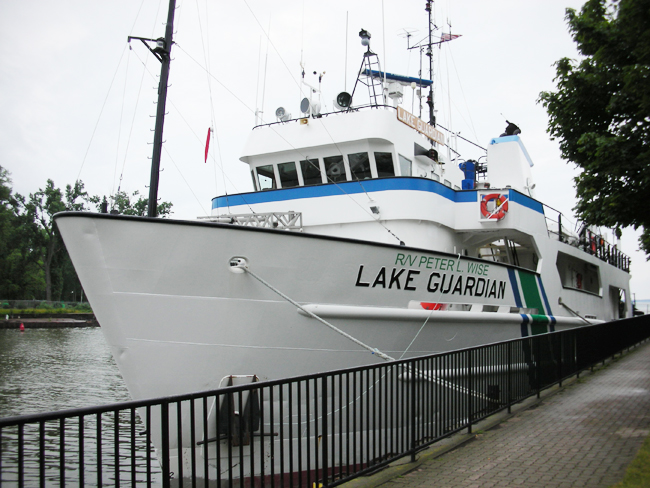
The
Guardian, the only self-contained non-polluting vessel on the
Great Lakes, won’t likely be back on this lake for about another five
years, as it will rotate through the other Great Lakes. These “inland seas” of
the U.S. — Lakes Huron, Superior, Michigan, Erie and Ontario — form the largest group of freshwater lakes on Earth,
containing over 20% of the world's surface fresh water.
Photo: Paul C. Focazio, NYSG
Next year, the Shipboard and Shoreline Science Workshop will take place on Lake Erie. On this Lake Ontario-centric excursion, though, the teachers selected will work alongside the research vessel scientists as they conduct their fieldwork, which, this year, includes studying species at the bottom of the food web, examining organisms living on the Lake's bottom, and monitoring water quality.
“This shipboard cruise is a meaningful and exciting way to energize teachers as they personally experience the interaction of the Great Lakes’ water, weather, aquatic species and other natural and man-made elements," said Domske this morning at the
U.S. Coast Guard station in Youngstown, NY, where the
Guardian is docked and being prepped to head out on the Lake this afternoon. "These teachers will collect and analyze data alongside scientists and work with colleagues to develop unique classroom teaching tools.”
After leaving the dock in Yougstown, the
Guardian will traverse Lake Ontario's waters in a counter-clockwise fashion, docking along the way at ports in Clayton and Oswego. During its six-day journey, the research vessel will pass by over a dozen “stations” in Lake Ontario (
noted in the map below by wavy lines),
where the educators will draw water and bottom sediment samples and, later, analyze them in the on-board laboratory. Again referring to the map below, after leaving Youngstown, the group's journey begins first in the west end of the Lake's basin, traveling the route as noted in a clockwise fashion.
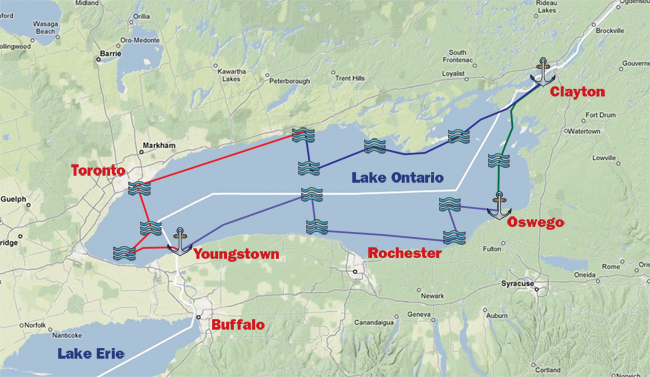
Once their journey aboard the
Guardian is complete, participants will
combine their on-deck activities with hands-on learning activities for
their students. They will each receive a
stipend to complete a stewardship project back in their classrooms and will have an opportunity to request
post-cruise follow-up assistance to facilitate their classroom
implementation from NYSG's Domske.
"The goal is for these teachers to ignite inspiration from the group's
enthusiasm and zest for learning that will not only help them make
long-lasting connections with each other, but also bring them a high level of energy
that they can bring back into their classrooms," said Domske.
And, let's not forget that the object of study for these teachers, Lake
Ontario, is quite a sizable one ...
- Nestled between the mighty Niagara River to the west and the picturesque St. Lawrence River Valley to its east, Lake Ontario is the 14th largest lake in the world (193 miles in length, 53 miles in width).
- Bordered to the north by Ontario, Canada, and to the south by New York State, it is the smallest in both surface area and size of the Great Lakes, fourth among them in maximum depth (802 feet), but second only to Lake Superior in average depth
(approximately 283 feet).
- With its greater average depth
than Lake Erie, Lake Ontario holds almost four times the
volume (393 cubic miles) and has a retention time of about six years. Lake retention time is a calculated quantity expressing the mean time that water spends in a particular lake.
- The
drainage basin covers parts of Ontario and New York, and a small portion
of Pennsylvania.
- Major urban industrial centers, such as Canada's Hamilton and
Toronto, are located on its shore. On the New York side, sites like Rochester, Oswego and Clayton are considered much more rural by comparison. Actually, the basin land area is largely rural with a significant forested and agricultural portion.
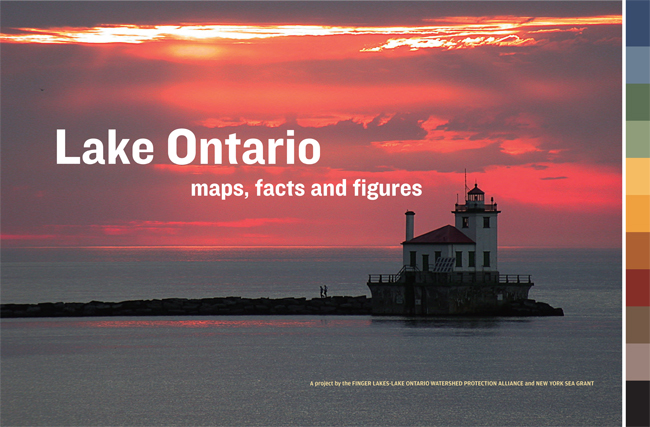
"Almost one-third of the land area of New York State drains into Lake Ontario, making the wise use and management of natural resources vital to the long-term sustainability of the Lake Ontario region’s ecology, environment and economy," says
Dave White, NYSG's Recreation & Tourism Specialist, who wrote the forward for 2011's
Lake Ontario: Maps, Facts and Figures (
pdf), a 28-page, full-color booklet produced in partnership with the
Finger Lakes-Lake Ontario Watershed Protection Alliance.

One variation from this year's "Shipboard and Shoreline Science" workshop versus the one from July 2008: That one began on Lake Erie on the docks of Buffalo instead of on Lake Ontario at Youngstown (
see map, above). From Buffalo, the
Guardian cruised through the eight
locks of the Welland Canal, passing through locks 8-1, in that order. From the first to the last lock in the system between Lakes Erie and Ontario there is an elevation change of about 327 feet, or almost 33 stories tall.
If you’ve never experienced going through a lock before, here’s a visual snapshot of how it looked from our last journey – think of it as going from the top to the bottom of a ladder, except with a lot of water in between.
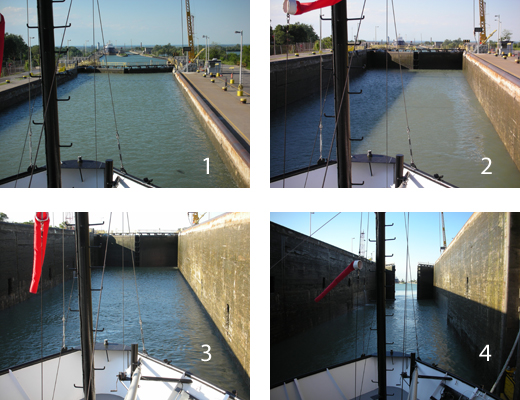
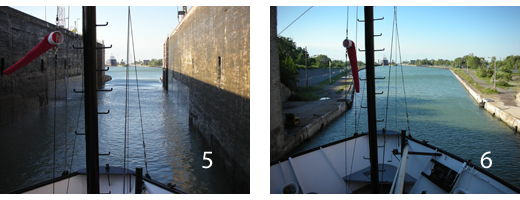 Photo Series: Paul C. Focazio, NYSG
Photo Series: Paul C. Focazio, NYSG
Great Lakes Sailing - A 10-minute Time Lapse of a Ship's Travel from Lake Erie to Lake Ontario through the locks of the Welland Canal (The standard journey takes around eight hours)
The Welland Canal is a ship canal in Canada that runs 42 km (27.0 miles)
from Port Colborne, Ontario on Lake Erie to Port Weller, Ontario on
Lake Ontario. As part of the St. Lawrence Seaway, the canal allows ships
to traverse the Niagara Escarpment and avoid Niagara Falls.
And here are two video clips of the doors of a lock opening to let the
Guardian through …